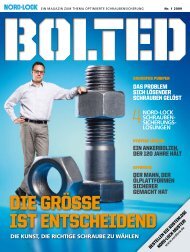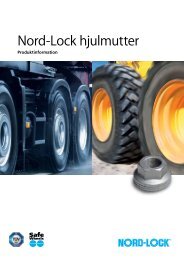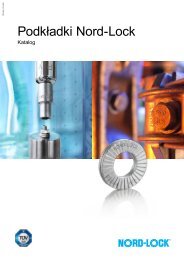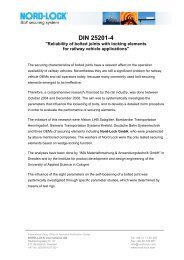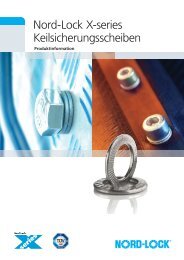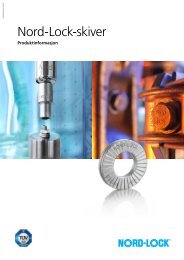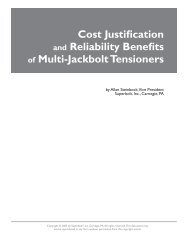Europe - Superbolt MJT installation & removal (English) - Nord-Lock
Europe - Superbolt MJT installation & removal (English) - Nord-Lock
Europe - Superbolt MJT installation & removal (English) - Nord-Lock
Create successful ePaper yourself
Turn your PDF publications into a flip-book with our unique Google optimized e-Paper software.
<strong>Nord</strong>-<strong>Lock</strong> AG 5.5-016 04/12<br />
<strong>Superbolt</strong><br />
Pretensioning Systems - Instructions
2<br />
By turning the jackbolts, a strong thrust force is<br />
generated. This thrust force is directed against a<br />
hardened washer.<br />
Jackbolts have a small friction diameter creating a high<br />
thrust force for relatively little torque.<br />
The loads are transfered through the nut body which is<br />
positioned on the main thread by hand.<br />
A hardened washer is used to transfer the force whilst<br />
protecting the flange face and nut body.<br />
The thrust force of many jackbolts and the opposite<br />
reaction force of the main bolt head create a strong<br />
clamping force on the flange.<br />
The thrust force from the jackbolt creates an equally<br />
strong reaction force in the main bolt head.
Instructions<br />
With <strong>Superbolt</strong> ® tensioners you have chosen a technologically superior product. It is purely<br />
mechanical and, therefore, very safe.<br />
The following simple steps will help you with your application. Thereby you increase safety, speed<br />
and service life.<br />
Content page/s<br />
1. Tightening procedure 4/5<br />
2. Loosening procedure 6/7<br />
3. Lubrication and tools 8/9<br />
4. Maintenance 10<br />
5. General notes 11<br />
6. Consultance 12<br />
These instructions are valid for <strong>Superbolt</strong> ® standard pretensioning systems<br />
according to <strong>Nord</strong>-<strong>Lock</strong> AG data sheets:<br />
Tensioners: – MT / MTT / MTL / MTA<br />
– MR / MRA<br />
– CY<br />
– SJ / SJL / SJX<br />
– GR2<br />
– SM<br />
– H650 / H650T<br />
– H850 / H850T<br />
– SH / SHT<br />
Torquebolts: – SB8<br />
– SB12<br />
– SBU<br />
– SSJ<br />
3
1. Tightening procedure<br />
1.1 Check:<br />
Which jackbolt torque?<br />
Recommended torque M see<br />
– your internal directives<br />
– <strong>Nord</strong>-<strong>Lock</strong> AG certificate<br />
– <strong>Nord</strong>-<strong>Lock</strong> AG data sheet<br />
4<br />
Attention: The jackbolt torque engraved on the<br />
tensioner body is the maximum value which may<br />
be unsuitable for your application. The indicated<br />
torques are theoretical values. The achieved<br />
elongations of the studs are relevant.<br />
1.2 Which tools?<br />
– suitable torque wrench<br />
– matching socket, heavy duty line<br />
– lubricant<br />
1.3 Preparation:<br />
– Clean main thread and contact areas and<br />
lubricate well with suitable anti-seize lubricant<br />
(A), put on washer (B).<br />
– Make certain that the jackbolts on the<br />
<strong>Superbolt</strong> ® tensioner do not protrude beyond<br />
the load surface and are well lubricated. If<br />
neccessary, relubricate with the recommended<br />
<strong>Superbolt</strong> ® lubricant (see certificate).<br />
– Firmly tighten tensioner by hand, if neccessary<br />
by using a screwdriver stuck between the<br />
jackbolts or the like (D).<br />
– Afterwards turn back approx. 1/4 turn.<br />
Depending on size the gap will be approx.<br />
1 to 3 mm wide (E).<br />
– The actual tightening occurs in a few steps:<br />
A<br />
C<br />
D<br />
E<br />
1–3 mm<br />
B
1.4 Tightening:<br />
Step 1:<br />
Tighten 4 jackbolts by hand or using a small<br />
wrench to center the main thread and to eliminate<br />
backlash. Tighten bolts crosswise.<br />
Step 2:<br />
Now tighten these 4 jackbolts<br />
crosswise with 50% of the<br />
recommended jackbolt torque.<br />
Step 3:<br />
Tighten the same 4 jackbolts<br />
crosswise with 100%.<br />
Step 4:<br />
Now change to circular tightening<br />
and tighten all jackbolts with 100%<br />
of the recommended jackbolt torque.<br />
Step 5:<br />
Repeat step 4 until all jackbolts are equally<br />
tightened (less than 20° remaining movement).<br />
Normally 2 to 3 passes are sufficient, with long<br />
bolts accordingly more.<br />
Power tools can save time, see item 3.3.<br />
50%<br />
100%<br />
100%<br />
3<br />
3<br />
1<br />
1<br />
2<br />
2<br />
4<br />
4<br />
5
2. Loosening procedure<br />
6<br />
Attention: Loosening requires an exact procedure.<br />
The jackbolts must be unloaded stepwise! Under<br />
no circumstances unload single screws completely.<br />
The remaining screws would have to carry the<br />
entire load and, therefore, would be difficult<br />
to loosen. In extreme cases the jackbolts could<br />
mushroom and make loosening impossible!<br />
2.1 Usage at normal temperatures (< 100 °C)<br />
Preparation: Before loosening apply penetrating oil,<br />
especially with any rust formation.<br />
Step 1:<br />
Starting with N° 1 loosen every jackbolt in a<br />
circular pattern approx. 1/4 turn (breaking loose is<br />
sufficient). After the first round jackbolt N° 1 will<br />
be tightened again, however, on a lower level of<br />
loading.<br />
Note: Should several tensioners be loosened, i.e.<br />
on a flange, perform step 1 on all tensioners before<br />
moving to step 2.<br />
Step 2:<br />
In a 2 nd round repeat step 1, again on all<br />
tensioners.<br />
Step 3:<br />
Repeat step 1 in a 3 rd round.<br />
Step 4:<br />
Relieve jackbolts completely. Now the tensioner can<br />
be removed by hand.<br />
Note: Long screws expand more and, therefore,<br />
may require one or two passes more.<br />
Attention: Before re-using follow maintenance<br />
instructions!<br />
1/4<br />
r
2.2 Usage at high temperatures (> 100 °C)<br />
Preparation: At higher temperatures the petroleum<br />
base of the lubricant evaporates, thereby<br />
increasing the effort for loosening.<br />
Step 1:<br />
If possible, already apply penetrating oil during<br />
cooling of the <strong>installation</strong> (at approx. 150 °C).<br />
At even higher temperatures use synthetic oil.<br />
Step 2:<br />
Starting with N° 1 break loose each jackbolt of one<br />
tensioner in a circular pattern.<br />
Note: Do not loosen beyond break loose point, and<br />
break loose all jackbolts of all tensioners of a joint<br />
first.<br />
Step 3:<br />
The actual loosening occurs according to the<br />
procedure described under item 2.1 (normal case),<br />
beginning with step 1.<br />
Note: For high temperature applications bolts with<br />
bores are often used. Through the use of heating<br />
rods the loosening of <strong>Superbolt</strong> ® tensioners can be<br />
substancially facilitated.<br />
Five minutes of heating are already sufficient to<br />
accelerate loosening.<br />
1/4<br />
7
3. Lubrication and tools<br />
3.1 Lubricant<br />
8<br />
Jackbolts: The jackbolts are delivered prelubricated<br />
and are ready for use. Refer to the<br />
cerficate for the lubricant. For jackbolts use only<br />
<strong>Superbolt</strong> ® lubricants or substitutes permitted by<br />
<strong>Nord</strong>-<strong>Lock</strong> AG.<br />
Hardened washers: For the upper side (contact<br />
with jackbolts) use the correct <strong>Superbolt</strong> ® lubricant.<br />
For the bottom side you may use any suitable antiseize<br />
lubricant.<br />
Main thread: Any suitable anti-seize lubricant<br />
including <strong>Superbolt</strong> ® lubricants may be used. Apply<br />
with brush or spray.<br />
3.2 Sockets<br />
For tightening the jackbolts only high quality tools<br />
in good working order should be used. Heavy duty<br />
sockets for use with impact tools are best suited.<br />
Worn sockets are dangerous and should be disposed<br />
of.<br />
3.3 Power tools<br />
Air impact tools have proven to be most suitable.<br />
However, with <strong>Superbolt</strong>® jackbolts they reach<br />
only 30…50% of their rated output. Therefore,<br />
the largest possible air lines and couplings should<br />
be used. Impact tools are suitable to a torque of<br />
max. 200 – 250 Nm. Pneumatic wrenches are<br />
recommended for large torques, which offer the<br />
same control as the impact tools.
3.3 Power tools (continuation)<br />
Adjustment of the correct torque: Tighten one<br />
jackbolt to the desired torque with the torque<br />
wrench. Then, apply the air impact tool and<br />
increase the pressure until the jackbolt starts<br />
turning again.<br />
Verifying the torque output of an air impact tool<br />
is easy: Tighten until tool stalls, then measure<br />
the torque with a torque wrench (preferably with<br />
electronic gauge).<br />
When tightening air impact tools are especially<br />
suited for steps 2 through 5 and should be<br />
adjusted to approx. 90 to 100% of the rated<br />
torque.<br />
Important: Because of the lower accuracy of<br />
power tools, the last tightening round should<br />
always be performed manually with a precision<br />
torque wrench.<br />
Attention: Only use air impact tools for<br />
tightening, never for loosening.<br />
Notes for the use of air impact tools:<br />
Network pressure min. 6,5 bar<br />
– up to 70 Nm 3/8” impact tool or air ratchet<br />
– 70-130 Nm 1/2” impact tool, derated (Attention: Do not overshoot!)<br />
– 130-200 Nm 1/2” impact tool<br />
– 200-270 Nm 1/2” impact tool (handy) or 3/4”<br />
– over 270 Nm 3/4” impact tool or 1”<br />
– over 400 Nm 3/4” air impact tool with reaction arm<br />
M [Nm]<br />
9
4. Maintenance<br />
4.1 Regular checks<br />
<strong>Superbolt</strong> ® tensioners do not loose their preload force even after several years in service<br />
provided that they are correctly tightened. During revisons (after several years) the preload<br />
force should be checked nevertheless. Use a torque wrench adjusted to 100% of the permitted<br />
jackbolt torque according to the cerficate or your <strong>installation</strong> procedure.<br />
10<br />
Should some jackbolts unexpectedly have lost some of the preload force the following<br />
procedure is recommended:<br />
– Loosen and remove a single jackbolt. Clean and lubricate with the anti-seize lubricant which<br />
is specified in the <strong>Nord</strong>-<strong>Lock</strong> AG certificate. Then replace jackbolt and retighten. Repeat for<br />
every jackbolt. Thus, the nut remains tensioned.<br />
– Now retension according to tightening procedure – step 5, meaning:<br />
Tighten in circular pattern with full jackbolt torque, until all jackbolts are tightened.<br />
4.2 Preventive maintenance<br />
i.e. for <strong>removal</strong> for maintenance purposes:<br />
– Relieve according to loosening procedure.<br />
– Clean thread and end of the <strong>Superbolt</strong> ®<br />
jackbolts and treat with lubricant according to<br />
certificate.<br />
Do not use molybdenum sulfide (MoS 2 ) unless<br />
expressly specified in the certificate.<br />
– <strong>Superbolt</strong> ® hardened washer may be re-used<br />
despite indentations simply by turning over.<br />
Depressions of a few 1/100 mm are normal.<br />
– Retighten according to tightening procedure.<br />
4.3 If you encounter problems<br />
Jackbolts cannot be loosened:<br />
– Try to free at least one jackbolt.<br />
– Remove, lubricate well and tighten with 110% of the recommended jackbolt torque.<br />
– The two neighboring jackbolts should become free.<br />
– Remove also, lubricate and tighten with 110%.<br />
– Again the next two jackbolts should become free.<br />
– And so on.<br />
– Afterwards relieve all jackbolts according to loosening procedure.<br />
Hardened washers are damaged i.e. after a long time in service:<br />
– Exchange against original <strong>Superbolt</strong> ® hardened washers.<br />
Jackbolts are damaged or missing:<br />
– Exchange against original <strong>Superbolt</strong> ® jackbolts.<br />
Do not use commercially available screws because they are not suitable for such high loads.<br />
Other problems:<br />
– Please contact your supplier or national <strong>Nord</strong>-<strong>Lock</strong> office directly.
5. General notes<br />
5.1 Tightening of tensioners with only 4 or 6 jackbolts<br />
Step 1: Tighten all jackbolts by hand crosswise.<br />
Step 2: Tighten 2 opposite jackbolts with 50% of recommended torque.<br />
Step 3: Tighten 2 other opposite jackbolts with 100%.<br />
Step 4: Tighten jackbolts in circular pattern with 100% until they are tightend.<br />
5.2 Tightening of long tie rods<br />
To accelerate tightening of long tie rods it pays off to perform step 4 with increased jackbolt<br />
torque (approx. 110–125%).<br />
Attention: In final rounds always check jackbolt torque by hand with 100% to prevent overloading.<br />
5.3 Gaskets with large elastic displacements<br />
It does not matter if some jackbolts (or tensioners on the circumference) become loose<br />
during tensioning. This is normal, because in the beginning only those bolts carry loads that are<br />
being tightened. Do not spin down loose tensioners, otherwise there will be problems later during<br />
loosing. Preferably adjust jackbolts with power tools.<br />
5.4 Tensioning large flanges or joints<br />
For tensioning large flanges/joints preferably work with 2 men 180° apart or 4 men 90° apart.<br />
5.5 Usage of spacers<br />
Tensioners should be positioned on the outer end of a bolt. This protects the main thread. It can<br />
be tensioned easier (no extensions neccessary) and the expansion is improved. Place suitable<br />
spacer or several heavy washers under the hardened washer. Thereby you can bridge over areas<br />
that have been damaged by other tightening techniques.<br />
5.6 Retensioning for high temperature applications<br />
If tensioned properly it should not become neccessary to retension SUPERBOLT ® tensioners. If<br />
regular retensioning should nonetheless become necessary, please inform us so that we can<br />
re-examine the joint.<br />
5.7 Recutting of the bolt threads can become neccessary on bolts that have deformed during<br />
years of service, especially at higher temperatures. Likewise on bolts of earlier manufacture<br />
that were manufactured with other tolerances.<br />
5.8 Installation tools<br />
Apart from a variety of standard tools for tensioning of <strong>Superbolt</strong> ® tensioners simple special<br />
tools are available, which facilate the <strong>installation</strong> of large nuts or bolts.<br />
5.9 Protective caps from vinyl, steel or stainless steel are available to<br />
protect the tensioners for different applications. Filled with grease<br />
they offer good potection against rust at normal temperatures.<br />
11
6. Consultance<br />
For further information on possible uses, applications<br />
and maintenance of <strong>Superbolt</strong> ® pretensioning systems<br />
please contact your supplier or national <strong>Nord</strong>-<strong>Lock</strong> office<br />
directly.<br />
These instructions are also available as information film.<br />
Exclusion of liability<br />
The <strong>Nord</strong>-<strong>Lock</strong> Group excludes all liability for unsuitable<br />
product selection, improper use as well as damage<br />
resulting from disregarding our instructions and<br />
directives.<br />
Changes due to technical progress are reserved.<br />
<strong>Nord</strong>-<strong>Lock</strong> AG<br />
Rietwiesstrasse 2, CH-8735 St. Gallenkappel, Switzerland<br />
Tel: +41 (0)55 284 64 64, Fax: +41 (0)55 284 64 69<br />
Email: info@nord-lock.ch<br />
<strong>Nord</strong>-<strong>Lock</strong> Group<br />
Tel: +46 (0)31 7192 300, Fax: +46 (0)40 240 851<br />
Email: info@nord-lock.com<br />
www.superbolt.com • www.nord-lock.com



